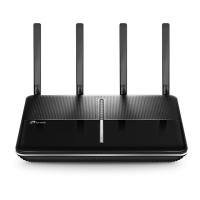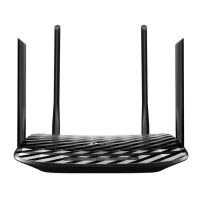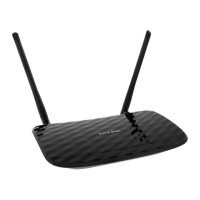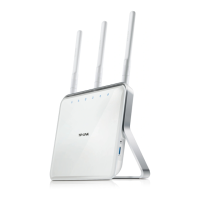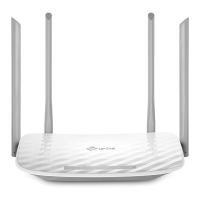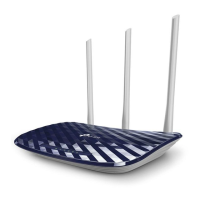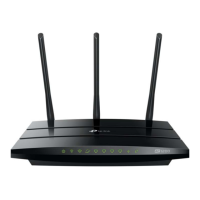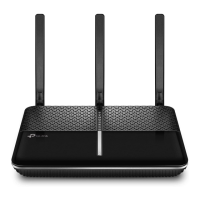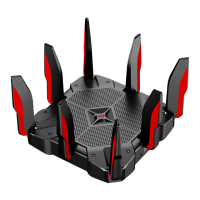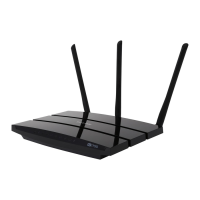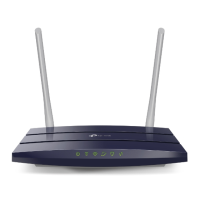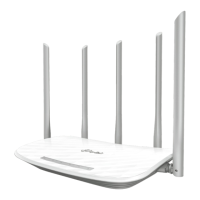Do you have a question about the TP-Link Archer C3200 and is the answer not in the manual?
Details the router's core functionalities, speed, security, and connectivity options.
Explains the front and rear panel components, including LED status indicators.
Covers system requirements and the physical steps to connect the router.
Guides users on how to log into the router's web interface for configuration.
Steps for both quick auto-detection and manual setup of internet connection types.
Instructions for configuring the router for IPv6 connectivity.
How to control and allocate internet bandwidth for devices on the network.
Implements MAC filtering and access control to manage device network access.
Binds IP to MAC addresses to prevent unauthorized network access and attacks.
Configures services like Virtual Servers and DMZ for external access to local resources.
Enables sharing of USB storage devices, files, and media on the network.
Restricts internet access for specific devices based on time and content.
Creates a separate Wi-Fi network for guests, isolating them from the main network.
Modifies LAN IP, DHCP settings, and wireless network configurations (SSID, password).
Configures secure VPN tunnels for remote access between networks.
Covers firmware updates, configuration backup/restore, and time settings.
Guides on how to retrieve or reset router login credentials and forgotten wireless passwords.
Provides solutions for when the router cannot access the internet after setup.
Guides on resolving issues with finding or connecting to wireless networks.
Details the router's core functionalities, speed, security, and connectivity options.
Explains the front and rear panel components, including LED status indicators.
Covers system requirements and the physical steps to connect the router.
Guides users on how to log into the router's web interface for configuration.
Steps for both quick auto-detection and manual setup of internet connection types.
Instructions for configuring the router for IPv6 connectivity.
How to control and allocate internet bandwidth for devices on the network.
Implements MAC filtering and access control to manage device network access.
Binds IP to MAC addresses to prevent unauthorized network access and attacks.
Configures services like Virtual Servers and DMZ for external access to local resources.
Enables sharing of USB storage devices, files, and media on the network.
Restricts internet access for specific devices based on time and content.
Creates a separate Wi-Fi network for guests, isolating them from the main network.
Modifies LAN IP, DHCP settings, and wireless network configurations (SSID, password).
Configures secure VPN tunnels for remote access between networks.
Covers firmware updates, configuration backup/restore, and time settings.
Guides on how to retrieve or reset router login credentials and forgotten wireless passwords.
Provides solutions for when the router cannot access the internet after setup.
Guides on resolving issues with finding or connecting to wireless networks.
| DSL WAN | - |
|---|---|
| Ethernet WAN | Yes |
| SIM card slot | No |
| Firewall security | Domain Filter, IP Address Binding, MAC Address Binding |
| Security algorithms | 64-bit WEP, 128-bit WEP, WPA, WPA-PSK, WPA2, WPA2-PSK |
| VPN support | PPTP, L2TP, IPSec |
| Cabling technology | 10/100/1000Base-T(X) |
| Networking standards | IEEE 802.11a, IEEE 802.11ac, IEEE 802.11b, IEEE 802.11g, IEEE 802.11n |
| Receiver sensitivity | 5GHz: 11a 6Mbps: -94dBm 11a 54Mbps: -76dBm 11ac HT20: -68dBm 11ac HT40: -64dBm 11ac HT80: -60dBm 2.4GHz 11g 54M: -77dBm 11n HT20: -73dBm 11n HT40: -71dBm |
| VPN tunnels quantity | 10 |
| Ethernet LAN data rates | 10, 100, 1000 Mbit/s |
| Ethernet LAN interface type | Gigabit Ethernet |
| Wi-Fi band | Tri-band (2.4 GHz / 5 GHz / 5 GHz) |
| Wi-Fi standards | 802.11a, Wi-Fi 5 (802.11ac), 802.11b, 802.11g, Wi-Fi 4 (802.11n) |
| Top Wi-Fi standard | Wi-Fi 5 (802.11ac) |
| WLAN data transfer rate (max) | 1300 Mbit/s |
| Number of WLAN connections (max) | 4 |
| WLAN data transfer rate (third band) | 600 Mbit/s |
| Product type | Tabletop router |
| Product color | Black |
| LED indicators | LAN, Link, Power, WLAN |
| Housing material | Plastic |
| USB 2.0 ports quantity | 1 |
| Output current | 5 A |
| Output voltage | 12 V |
| Power source type | AC |
| Storage temperature (T-T) | -40 - 70 °C |
| Operating temperature (T-T) | 0 - 40 °C |
| Storage relative humidity (H-H) | 5 - 90 % |
| Operating relative humidity (H-H) | 10 - 90 % |
| Certification | CE, FCC, RoHS |
| Antennas quantity | 6 |
| Cables included | LAN (RJ-45) |
| Package type | Box |
| Width | 200 mm |
|---|---|
| Height | 39 mm |
